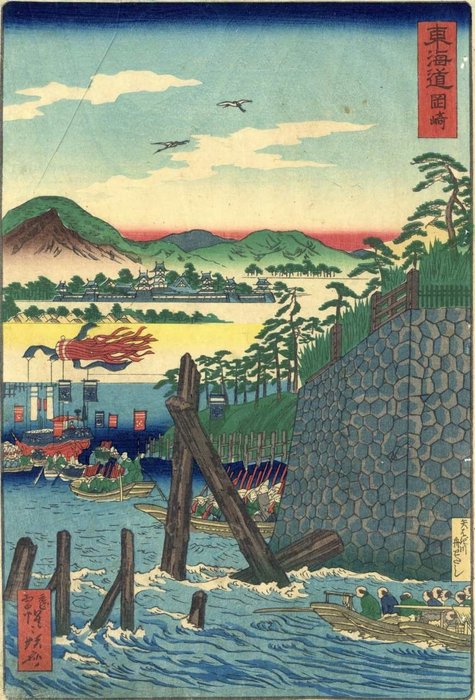
原始木版印刷 - 纸 - Sekino Junichirō 関野準一郎 (1914-1988) - "Atagozan" 愛宕山 (Atago Mountain) - 日本 - 约 1955 年
编号 82650707

编号 82650707

Original woodblock print - Paper - Kawanabe Kyosai (1831-1889) -Ya hagi Kawafune watashi 矢はぎ川舟わたし(Yahagi river boat ferry) - From the series "Tôkaidô meisho no uchi" 東海道名所之内 (Scenes of Famous Places along the Tôkaidô) (Processional Tokaido) - Japan - 1863 (Bunkyû 3)
This woodblock print 143 series
The signature is chikamaru-e(応需 惺々狂斎画)
Good condition, binding holes, spots, dirt
See Museum of Fine Arts, Boston: https://collections.mfa.org/objects/210141
Born in 1831 in Furukawaishi-cho, Shimousa (currently 2-chome, Chuo-cho, Koga-shi, Ibaraki) as the second son of Kiemon Kawanabe.
In Tenpo 4 period (1833), Shuzaburo went to the Taguchi family, a relative of Tatebayashi, with his mother. At this time, Shuzaburo made a sketch for the first time.
In the Tenpo 8 period (1837), he became a disciple of Utagawa Kuniyoshi, an ukiyo-e artist.
He taught that he should be observed carefully. In order to faithfully carry out the teachings of this teacher, the young Kyosai wandered around the poor tenement house with a picture book in his hand all day, searching for fights and quarrels for sketching.
In May 1839 (Tenpo 10 period), he sketch the raw neck that flowed in the Kanda River when the rainy season flooded,leaving behind the legend of "raw neck sketch(生首の写生)" that surprised the surroundings.
In 1852, Kyosai also studied a wide range of ancient Japanese painting styles such as Tosa school(土佐派), Rinpa school(琳派), Shijo school(四条派), and Ukiyo-e.
In the 5th year of Ansei (1858), he left the Kano school and called "Shojo Kyousai(惺々狂斎)", and began drawing ukiyo-e and gained popularity in caricatures and caricatures.
The work exhibited this time is a work of this time
In 1880, he drew a 17m wide and 4m high "Yokai Hikimaku(妖怪引幕)" (collected by Waseda University Theater Museum) for Shintomi-za in 4 hours. In 1881, the "Koboku Kan Azu(枯木寒鴉図)" (Eitaro Sohonpo) exhibited at the 2nd National Industrial Exhibition was awarded the " 妙技二等賞牌(Miyougi nitoushou".
In the same 14th year of the Meiji era, the hired foreign architect Josiah Conder became a disciple. Condor seems to have been close enough to be given the title of "暁英", which means "ei英" in England, and the exchange between the two can be seen in his picture diary of Kyousai mentioned above.